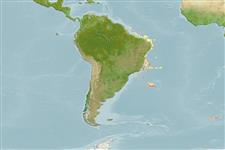Élasmobranches (requins et raies) (sharks and rays) >
Rajiformes (Skates and rays) >
Rajidae (Skates)
Etymology: Malacoraja: Greek, malakos = soft + Latin, raja, -ae = ray, fis (Raja sp.) (Ref. 45335); obscura: Specific name derived from the Latin obscurus, meaning dark or indistinct, in reference to the the subtle nature of the differences separating this species from its congeners..
Environment: milieu / climate zone / depth range / distribution range
Écologie
marin bathydémersal; profondeur 808 - 1105 m (Ref. 72455). Tropical
Distribution
Pays | Zones FAO | Écosystèmes | Occurrences | Point map | Introductions | Faunafri
Southwestern Atlantic: continental slope of southeastern Brazil, off the states of Espirito Santo (19°39' S, 38°38' W) and Rio de Janeiro (21°46' S, 39°53' W).
Taille / Poids / Âge
Maturity: Lm ? range ? - ? cm
Max length : 68.0 cm TL mâle / non sexé; (Ref. 72455)
Life cycle and mating behavior
Maturité | Reproduction | Frai | Œufs | Fécondité | Larves
de Carvalho, M.R., U.L. Gomes and O.B.F. Gadig, 2005. Description of a new species of skate of the genus Malacoraja Stehmann, 1970: the first species from the southwestern Atlantic Ocean, with notes on generic monophyly and composition (Chondrichthyes: Rajidae). Neotrop. Ichthyol. 3(2):239-258. (Ref. 72455)
Statut dans la liste rouge de l'IUCN (Ref. 130435)
Menace pour l'homme
Harmless
Utilisations par l'homme
Plus d'informations
PaysZones FAOÉcosystèmesOccurrencesIntroductionsStocksÉcologieRégime alimentaireÉléments du régime alimentaireConsommation alimentaireRation
Noms communsSynonymesMétabolismePrédateursÉcotoxicologieReproductionMaturitéFraiRassemblement de ponteFéconditéŒufsDéveloppement de l'œuf
Taille/Âge
Croissance
Longueur-poids
Longueur-longueur
Fréquences de longueurs
Morphométrie
Morphologie
Larves
Dynamique des populations larvaires
Recrutement
Abondance
BRUVS
RéférencesAquacultureProfil d'aquacultureSouchesGénétiqueElectrophoresesHéritabilitéPathologiesTraitementNutrientsMass conversion
CollaborateursImagesStamps, Coins Misc.SonsCiguateraVitesseType de nageSurface branchialeOtolithesCerveauxVision
Outils
Articles particuliers
Télécharger en XML
Sources Internet
Estimates based on models
Preferred temperature (Ref.
123201): 4 - 4.5, mean 4.1 °C (based on 7 cells).
Phylogenetic diversity index (Ref.
82804): PD
50 = 0.5625 [Uniqueness, from 0.5 = low to 2.0 = high].
Bayesian length-weight: a=0.00302 (0.00141 - 0.00645), b=3.24 (3.07 - 3.41), in cm total length, based on LWR estimates for this (Sub)family-body shape (Ref.
93245).
Niveau trophique (Ref.
69278): 3.6 ±0.4 se; based on size and trophs of closest relatives
Résilience (Ref.
120179): Faible, temps minimum de doublement de population : 4,5 à 14 années (Preliminary low fecundity).
Fishing Vulnerability (Ref.
59153): Moderate to high vulnerability (47 of 100).
